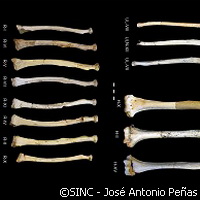Scientists piece together Homo heidelbergensis height puzzle
Researchers in Spain have reconstructed the human limb bones of Homo heidelbergensis found in the Sierra de Atapuerca in Burgos. The finding helps shed light on the height of various species of the Pleistocene era, showing that Homo heidelbergensis, like Neanderthals, had more or less the same height as that of modern man living in the Mediterranean region and central Europe. The study was published in the Journal of Human Evolution. The University of Burgos researchers reconstructed 27 complete bones around 500 000 years old. The team also found a considerable number of fossils around the area. 'The incredible collection allows us to estimate the height of species, such as Homo heidelbergensis, who inhabited Europe during the Middle Pleistocene era and is the ancestor of the Neanderthal,' the Scientific Information and News Service (SINC) quoted lead author José Miguel Carretero Díaz from Burgos' Laboratory of Human Evolution as saying. The team identified whether the bones belonged to men or women because they were in complete form, which in turn allowed the researchers to measure height. 'Estimations to date were based on incomplete bone samples, the length of which had to be estimated too,' Professor Carretero Díaz said. 'We also used to use formulas based on just one reference population and we were not even sure as to its appropriateness.' Multiracial and multigender formulas were used to estimate the height for the entire population, helping reduce the error margin and get results that are as realistic as possible. 'We calculated an overall average for the sample and one for each of the sexes,' the Burgos researcher said. 'The same was done with the Neanderthal and Cro-Magnon fossils.' The data indicate that men and women in the Sima de los Huesos population were on average slightly taller than their Neanderthal counterparts. 'Neither can be described as being short and both are placed in the medium and above-medium height categories,' Professor Carretero Díaz said. 'But both species featured tall individuals.' The humans who arrived in Europe during the Upper Palaeolithic era, Cro-Magnons or anatomically modern humans, replaced the Neanderthal populations, according to the researchers. They found a considerable difference in height between them and other human species, representing what we call 'tall' people. No change emerged in height for around two million years. The findings suggest that all documented humans during the Early and Middle Pleistocene Era that inhabited Europe, Africa and Asia had medium to above-medium heights for around 2 million years. But 'amongst every population we have found a tall or very tall individual', according to the researchers. In a nutshell, the team proposes that the height of the Homo genus was relatively stable for 2 million years until a 'groundbreaking species in this sense' in Africa emerged 200 000 years ago: the Homo sapiens. Said Professor Carretero Díaz: 'The explanation is found in the overall morphological change in the body biotype that prevailed in our species compared to our ancestors. The Homo sapiens had a slimmer body, lighter bones, longer legs and were taller. Larger legs, narrower hips, being taller and having lighter bones not only meant a reduction in body weight (less muscular fat) but a bigger stride, greater speed and a lower energy cost when moving the body, walking or running.' Experts from the United Kingdom and the United States contributed to this study.For more information, please visit: University of Burgos:http://www.ubu.es/es/english-informationJournal of Human Evolution:http://www.journals.elsevier.com/journal-of-human-evolution/
Countries
Spain, United Kingdom, United States



